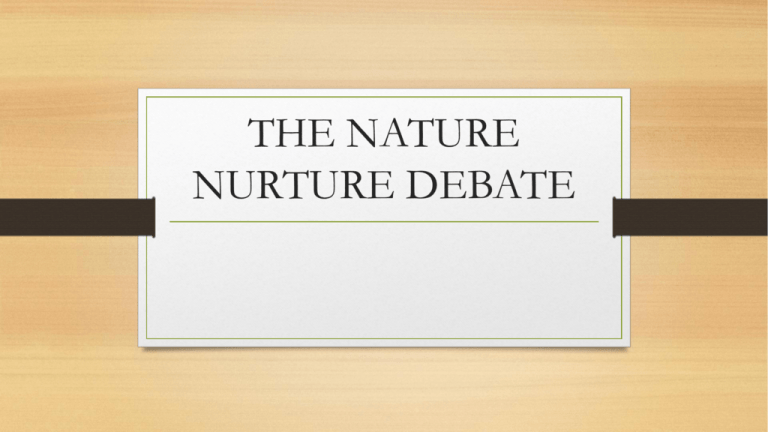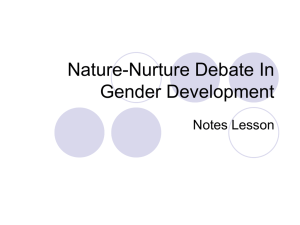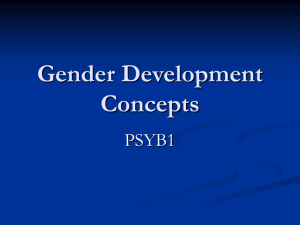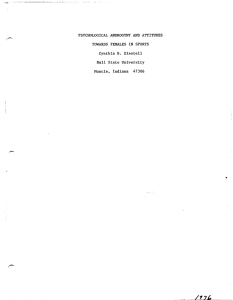THE NATURE NURTURE DEBATE
advertisement

THE NATURE NURTURE DEBATE Todays main objectives. • To understand the definitions and related concepts of “nature” and “nurture” in relation to both GENDER DEVELOPMENT • To be able to link back this knowledge to the Horizon – is your brain male or female documentary that we have watched in preparation. • To understand WHY we use and WHAT twin studies tell us about the nature nurture debate in relation to gender and intelligence. • Assignment criteria signposting 1.1, 1.2, 3.1,3.2 Definition The nature/nurture debate for gender in psychology considers the extent to which our gender and intelligence is determined by: Nature - genes and hormones or Nurture - learning from the environment). Research Methods for Nature/Nurture TWIN STUDIES • Take a look at this rather good explanation by Lord Robert Winston, relates mostly to IQ which we will look at next week but allows you to see how its done. • http://www.youtube.com/watch?v=bRKbZtpBcgI • Unfortunately not all twin studies are good or ethical, watch and be surprised. • http://www.youtube.com/watch?v=1gwnzW4jOMI Lets Recap • In preparation we have watched Horizon examining issues relating to Gender Development. • Can you recall some of the key things that were highlighted? • What did you think about the studies? Are they reliable methods? Would you make any changes? • Ethics? Terms • Sex - refers to the biological aspect e.g. genitals) • Gender – refers to the social aspects of males/females • Gender role – society’s expectations of behaviour/attitude expected of males and females • Gender stereotypes – the belief that all males/females act in certain ways • Gender identity – knowing that you are male/female • Androgyny – having high amounts of both typically masculine and feminine characteristics and behaviour Sex and Gender • Sex and gender have separate definitions although they are often used to mean the same thing Gender • Babies are assigned with a gender at birth. • It is the psychological and cultural ideas of what a male or female is that truly define our gender Sex • Refers to the biological aspects of the individual , which can be determined by a number of factors, including: • • • • • Chromosomes: females have an XX chromosomes, while males have an XY Reproductive organs: ovaries in females, testes in males Hormones: oestrogen and progesterone in females, testosterone in males Genital appearance Chromosomes and genital appearance usually correspond, but not always Goldwyn (1979) • Case of hermaphrodites • Aim: to illustrate the difference between sex and gender • Method: case study of 18 year old Bantu boy called Mr Blackwell – he developed breasts at puberty and had one active ovary and one active testes • Result: elected to have female parts removed leaving original gender identity • Conclusion: carried on life as a male – so the study shows that there is difference between gender and identity Evidence for Nature • Van Goozen found evidence that gender behaviour is controlled by hormones and nature. Male to female transsexuals were injected with the female hormone oestrogen, they showed less aggression but an increase in verbal fluency. This suggests that the hormone oestrogen makes females less aggressive and better verbally than males. • Can you identify a criticism of the Van Goozen study? • How can this be used to criticize the conclusions drawn from the study? Bem (1974) • Defined androgyny as having high amounts of both masculine and feminine characteristics • Example, a person could be independent (traditionally a male characteristic) yet also kind and caring (traditionally a feminine characteristic) • She carried out a study to investigate this Study • Aim: to investigate masculine and feminine traits/characteristics of an individual • Method: Bem sex-role-inventory - a questionnaire made up of a number of traits/characteristics. Participants have to rate how each of the traits apply to themselves • Results/conclusion: Individuals may possess both masculine and feminine characteristics. Those that possess them both in high measures are termed androgynous Stereotypes • Sex role stereotypes are overgeneralisations of the way that people view men and women. • They are determined by the society in which we live Stereotypes • Common stereotypes of the gender differences. Male Aggressive Display leadership Mechanical Takes a stand Competitive Ambitious Female Tactful Gentle Emotional Understanding Easily hurt Smith and Lloyd (1978) • Aim: to investigate whether mothers will treat a baby in a stereotyped way depending on whether it is thought to be a boy or a girl • Method: An experiment: IV – how baby dressed (pink or blue) DV- how child treated Same baby dressed sometimes in pink sometimes in blue, various mother were then asked to play with the baby Results If a mother thought she was playing with a boy, she would play more roughly and offer male stereotype toys. (e.g. cars). If she thought she was playing with a girl, she would talk to her and be more gentle Conclusion: Mothers treated babies in a stereotyped way, according to their gender SAME AS THE HORIZON STUDY!!! Durkin • Aim: to investigate if gender stereotyping is shown in TV advertising • Method: Used content analysis of TV advertisement • Results: Men outnumbered women 7:3 on adverts. Men were shown more frequently in dominant roles (higher occupational status – e.g. doctors, managers and judges, whereas women are portrayed as being in lower occupations e.g. housewives, nurses and secretaries • Conclusion: sex role stereotyping is shown in adverts Homework – Research in detail. • • • • • Durkin – adverts – stereotyping Smith and Lloyd – Baby stereotyping Bem – androgyny Goldwyn – hermaphroditism – sex and gender Money and Erhardt – girls with XX chromosomes but male genitals








